|
By Leti Wesolowski, contributor Valerie Bartron is a self-taught artist who has been designing lampwork beads and jewelry since 2012. She creates her original art using an oxygen and propane fueled torch, Italian glass and American-made double helix glass. She achieves unusual and interesting designs by adding pure silver, enamel powders and special reduction frit and annealing each piece for lasting durability. She has been a member of Commonwheel for over a year now and has participated with her lampwork jewelry at many gallery shows and at our Labor Day Weekend Art Festival. Valerie enjoys creating unique “molten treasures” to fit her customer’s unique styles. How did you get interested in lampworking? It was purely serendipity! A good friend was preparing for an overseas move. Unbeknownst to me she had a lampwork studio she hadn't touched for well over five years and she decided to sell it off. At a luncheon she asked if any of us might be interested in purchasing her studio. When I asked what type of studio set up she had she said “lampwork”. I thought she was talking about light fixtures. That's how unfamiliar I was with this art! I was curious and asked if she could show me exactly what she did. After the luncheon I went directly to her house and watched her make a simple round bead. That was the beginning of my love affair with glass art i.e. lampwork! Where do you get inspiration? I love natural beauty. I find inspiration in such things as landscapes, flowers, beautiful fabrics, just to name a few. I also love texture! I've realized most of my beads have a raised design or texture. I also get inspiration from people's needs. Tell us about your creative process-- how do you transform a rod of glass into a perfect glass bead? When I notice something particularly beautiful I take note of the colors and shapes. I'll try to figure out how to create this in glass. As strange as it might sound, it's not unusual for me to dream of a way to achieve the different layers of glass to make what I see in my mind’s eye. Is there a glass artist(s) that you admire/follow? Yes! Astrid Riedel from South Africa, Patty Leota Genack from Beulah, CO., and Jody Welch from Black Forest, CO., to name just a few. Their work is absolutely amazing! I’ll never stop learning from others. There are glass beads and then there are amazing tree of life pendants! Which one do you enjoy the most? The Tree of Life pendants are definitely the ones I enjoy making. Partly because they seem to represent something special for so many. I find it humbling and fulfilling when somebody purchases a piece that isn't simply jewelry but symbolizes something really special to them. It took a long time to develop the skills to make the Tree of Life pendant. They take many hours from start to the finished product. What is your proudest achievement? I'm fairly new to this medium. I've only been a lampworker for just short of five years. After a year of continuous work my oldest daughter asked if she could bring some of my beads into a well-established bead shop to see if they would be interested in buying them. When they ended up buying over $900 worth and asked me to continue to bring beads in, that was without a doubt a day I won't forget. Being accepted into the Commonwheel Artists Co-op was a thrill! I was searching for someone to make sterling silver neck rings to hang my Tree of Life pendants. I met up with a husband and wife team, members of the Commonwheel. They do beautiful sterling silver work! I brought in a few of my pieces I had intended to hang off the neck rings. They were very kind and said they loved my work. They told me when a space became available for a jeweler that I should apply. It took a little over a year before one opened. The rest is history… What is your best seller/ your favorite piece of all time? What is the story behind it? I love making all sorts of beads! The Tree of Life pendants are without question my best seller. I love the mountain setting in which we live in. I wanted to see if I could capture in some small way our beautiful scenery. That's how the Tree of Life pendant was born. The vessels are special to me as well. I have several clients that have purchased multiple vessels for essential oils. An example was a close friend who was preparing for a trip to Italy. She was nervous as she gets motion sickness. She often used essential oils to help soothe her symptoms. Her mother wanting to give her something special as a departing gift asked if I could make a piece of jewelry to be worn to hold the essential oils. That's when I taught myself how to make small vessels. I used her favorite colors along with some sterling silver foil inherited from her grandfather who was once a jeweler. I've also made vessels for people that wish to put their pets or loved ones’ ashes in. I permanently seal them. No one knows except for the client what is held inside. I've also made beads with ash encased inside to put into a necklace. It's not for everyone but those that choose to do it seem to get comfort from having it close and unassuming. What’s next for you? I work in what's called soft glass. Simply said this glass melts at a lower temperature than other art glass. There are so many beautiful colors to choose from. It's easy to get carried away. Before you know it you've invested in thousands of dollars’ worth! There's a fabulous glass, Double Helix which is a reactive glass, meaning it changes colors depending on the type of flame you put it in. It's a difficult glass to learn to use but the rewards are amazing! I'm on my third torch and have another on order. Each type of torch is used for a specific type of work. I started off with a $45 Hothead which was perfect to learn on. As my pieces got a little bigger and the detail more refined I purchased new torches. I'm always looking for something new and unique I can make. If I get stumped on how to achieve a certain technique, there are wonderful online lampwork communities to tap into! In the past I've always purchased sterling silver pieces to hang my pendants on as well as chain. I'm just beginning to learn how to do my own soldering and create my own bails for my pieces. Recently I've started incorporating semi-precious stone chain to enhance my work. I could do this work for another 30 years and just scratch the surface of possibilities! To see Valerie’s designs in person visit Commonwheel Artist Co-op and take advantage of 10% off all purchases of Valerie’s jewelry in April 2017. She offers a wide selection of necklaces, pendants on chains, loose beads, earrings and bracelets.
You can find her work also at our online shop here. Locally, her loose beads are sold in White Rabbit Beads and heArt Market in old Colorado City, and Chimayo Turquoise in Woodland Park. Follow her Facebook page at facebook.com/atouchofglassforyou Did you enjoy this post? Leave as a comment and let us know! We’d love to hear from you! Want more local art news delivered to your inbox? Sign up for Commonwheel newsletter here.
2 Comments
by Leti Wesolowski After retiring from teaching for 31 years, Sonny pursued the art of photography. In an effort to continually improve his work he took many workshops from renowned contemporary photographers such as Galen Rowell, John Shaw, George Lepp, John Fielder, and David Middleton. Sonny’s photography encompasses both traditional and non-traditional views of our surroundings and his travels around the world, always looking for the perfect light that the eye sees, not just what the camera captures, or a viewpoint that others might miss as we hurry through life. How did you get interested in photography? I was the Historian for my college fraternity and had to make a scrapbook of photos for the year and the photos were never as good as I thought they should be-I wanted to get better. Then for a college graduation gift my Mom paid for several courses of photography at The Center of the Eye Photography School in Aspen, Colorado. That's when I fell in love with CO and photography too. Where do you get inspiration? Are there certain times of the year of certain places where you feel more creative? In Colorado, basically all you have to do is look out the window to find inspiration. We live in such a beautiful state. Inspiration is everywhere. We heard your favorite time of day to photograph landscape is at sunrise and sunset. Would you tell us what is it that you look for on a landscape/scenery? What is the visual effect or emotion you look for capturing? I look for a special composition that stands out because of the lighting upon it whether it be a grand landscape or a close up of an aspen leaf with dew drops on it. What part of the process you enjoy the most? The most enjoyable part of photography for me is to see a finished photograph come out exactly the way that I had envisioned it to. When I first started, my photographs did not live up to what I was seeing, but after much practice and several courses (and better equipment) the photographs are much improved. We've seen an amazing portfolio of photographs from your world travels—Africa, Japan, Nepal—where you dabbed into a multitude of photographic genres besides landscape: portrait, wildlife, architectural. Which genre(s) is/are your favorite? Which one you enjoy the most? Which one is the most challenging? My favorite genre is still landscape photography, but probably the most challenging for me is taking portraits of the people I see on my travels. What is your proudest achievement? My proudest achievement was getting published in Outdoor Photographer Magazine for a Favorite Places article that I wrote and provided the photo for! What is your best seller and where was it taken? Picking my best seller is difficult, but would come from one of three: "Truly Colorado", "Sky Dancer" or "Aspens and Mist" triptych -all taken in CO. What's next for you?
I would like to visit Antelope Canyon this year, maybe even take a seminar there. I have seen some incredible photography from that location. The best place to purchase Sonny's photos would be at Commonwheel Artist's Co-op in Manitou Springs, CO. Visit the shop to get 10% off all purchases of Sonny’s photography this month. You can find examples of his work here and at imagekind by Leti Wesolowski We put out a call for mandala-related art and our local artists stepped up to the challenge. The “Mandala” show currently in our gallery is the result. 17 artists brought in mandala-related art from diverse points of views and inspiration—from patterns of nature, symbols from different cultures, colors, and the practice of centering and meditation. The works explore multiple medias but all embody the concept of “mandala”: fused glass; watercolor; digital photography; bronze, silver, and copper; precious metal clays; mixed media; stained glass; laser-cut wood; hand stamped clay; polymer clay; engraved terracotta; vinyl records; color pencil drawings; and more. We invite you to contemplate mandalas made by local artists and discover which one evokes feelings of peace, balance, unity and strength that resonate with you. Let them work their magic on your life and allow your mind to wander into the beauty of mandalas. “Mandala” comes from a Sanskrit word that means “circle or disc”. In art, mandala is often a symbolic pattern usually in the form of a circle within a square divided into four symmetric sections containing a unifying center from which geometric shapes and symbols radiate outwards. “The mandala is an archetypal image whose occurrence is attested throughout the ages. It signifies the wholeness of the Self.” —Carl G. Jung, Memories, Dreams and Reflections Embraced by many religions and cultures around the world, a mandala represents wholeness and the connection between inner self and outer reality. “In Christianity, there are a number of sacred images and ritual invocations that use the circular shape to connect the spiritual realm with the earthly realm”, says figurative sculptor Marica Hefti. “The placement of divine beings, angelic figures, and holy personages at crucial positions within the circular (stained glass) windows (of Christian cathedrals) establishes the powerful storyline of Christian beliefs”. Hindus were one of the first people to use mandalas as spiritual tools. Native Americans use mandalas as shields of good luck, prosperity, wealth and happiness. Buddhist monks create sand mandalas, a process that takes days to create, then sweep it and pour it into a river, to symbolize the never-ending cycle of life. “A concept of new beginnings, forms of life itself” says Tracey Eastland when asked to explain what a mandala means to him. Mandala is used in spiritual practices as a focal point for meditation, self-awareness, and healing. For digital photographer Teri Rowan, a mandala is “meant to inspire meditation and introspection” or can be admired for just its beauty. Metalsmith Kathleen Krucoff thinks a mandala is “a beautiful symbol to convey positive messages of encouragement and support”. In art, mandala has become a generic term for any diagram, chart, or geometric pattern that represents the center of the universe, metaphysically or symbolically. For Jewelry artist Connie Lorig, a mandala represents “a complex dance between unity and diversity, between the parts and the whole.” For artist Sheila Hewlett, mandala means the continuity of life. Commonwheel artist Julia Wright takes pictures of nature during her hikes and then edit them on her computer to create hypnotic mandalas. Designing a mandala is a unique personal experience in which the individual lets the creative mind to run free and find the symphony of shapes, colors and patterns to represent their unique sense of self and view of reality. Sculptor m.jo hart says “mandalas represent the process and meditation involved in creating her work”, which is focused on women’s issues, unique stories and experiences. Mandalas can be created by individuals to symbolize their journeys through life, their state of mind or to tell their personal story. Some of our artists got inspired by Celtic art, such as lampwork artists Jon Murray and Amanda Shotts who incorporate in their mandala barrettes “a circular pattern that has no beginning and no ending, signifying infinity of love!” Or Glass artist Sabine Wachs who “was drawn to the Celtic spiral mandalas used as symbols of the sun powering all life”. Jeweler Mary Cowdery got inspired by the yin-yang symbol, repetition and balance. Artist Ray Jordan loves bright whimsical colors. His biggest inspiration is combining bright colors with his love of painting, drawing and cutting wood. Kendrick Cowdery has a strong desire to maintain peace in his life. His handmade mandala lamp is built on mat board using a laser cutter and colorful translucent paper. Several artists took it as a chance to explore new themes and materials, such as mosaic artist Juanita Canzoneri who jumped at the opportunity to play with alcohol inks and raid her stash of stained glass. She found that, during the process, mos of her work reminded her of an art form from her childhood in eastern Pennsylvania. Others worked in new themes with their primary media, such as potter Jennifer Hanson who creates mandalas on her clay dishes with different hand stamps. Or illustrator and mixed media artist Kelly Green who finds that vinyl albums automatically lend themselves to the mandala format. Creating a mandala can be an enriching personal experience. To draw a mandala, one starts by “drawing the circle, setting an intention, centering through a meditation, usually start at the “bindu” sacred center and follow inspiration that comes” explains Mandala instructor Anne Roe. She sees mandalas “as “windows to the soul”, sacred circles and opportunities for the soulful self to express authentically”. Sometimes mandalas are created to evoke feelings of peace and contentment on the observer. Kathleen Krucoff, for example, wanted her pieces to “help the wearer feel empowered” focusing in tranquility and strength. Ray Jordan wanted to “bring a smile to the art viewer mind and make them think”.
|
Juanita Canzoneri
|



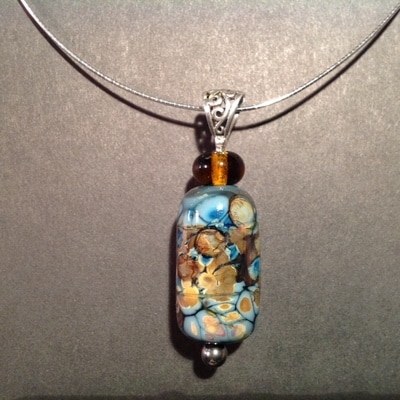




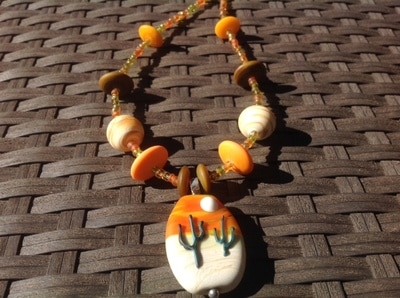












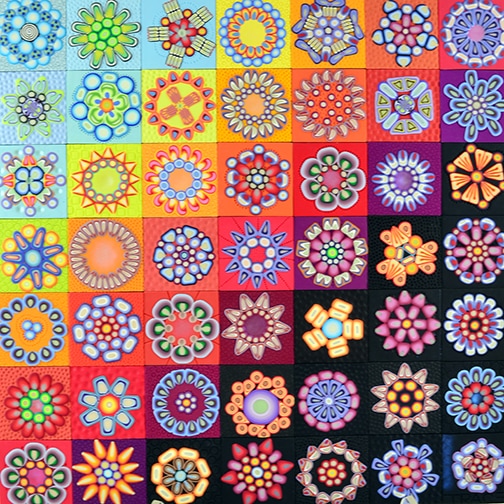



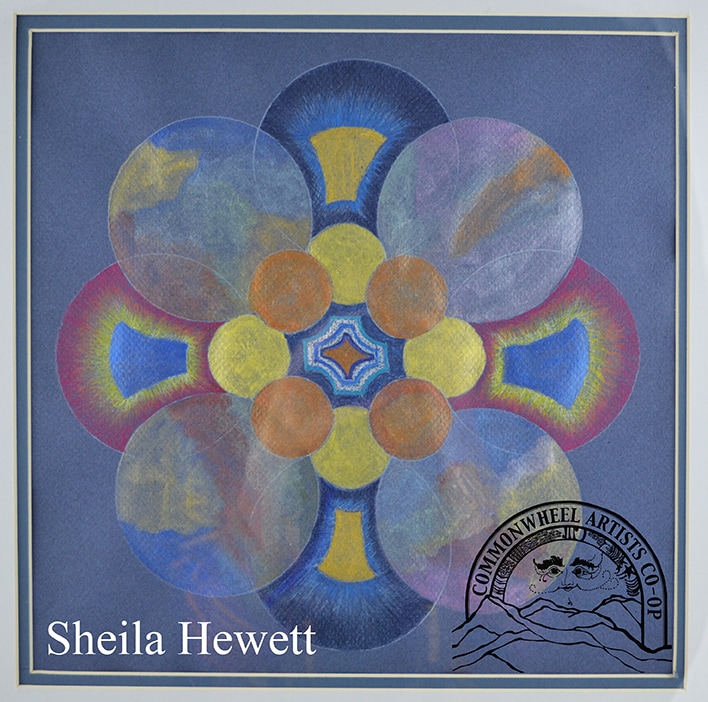





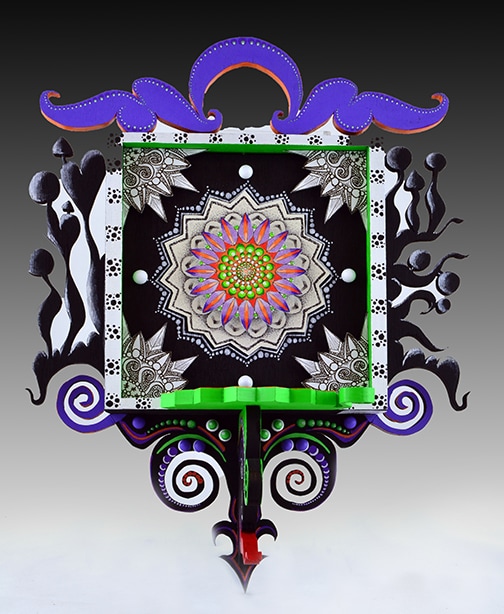



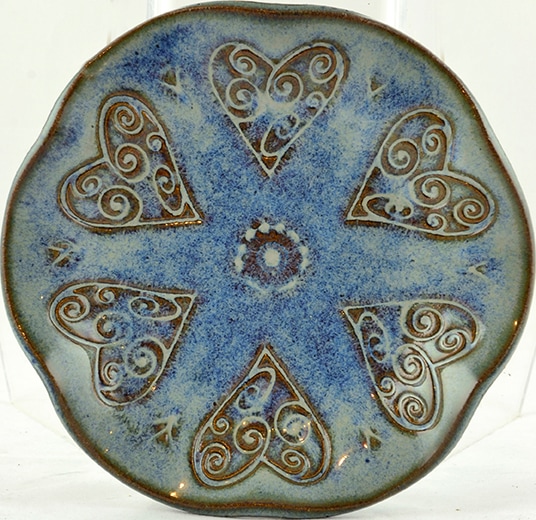


 RSS Feed
RSS Feed